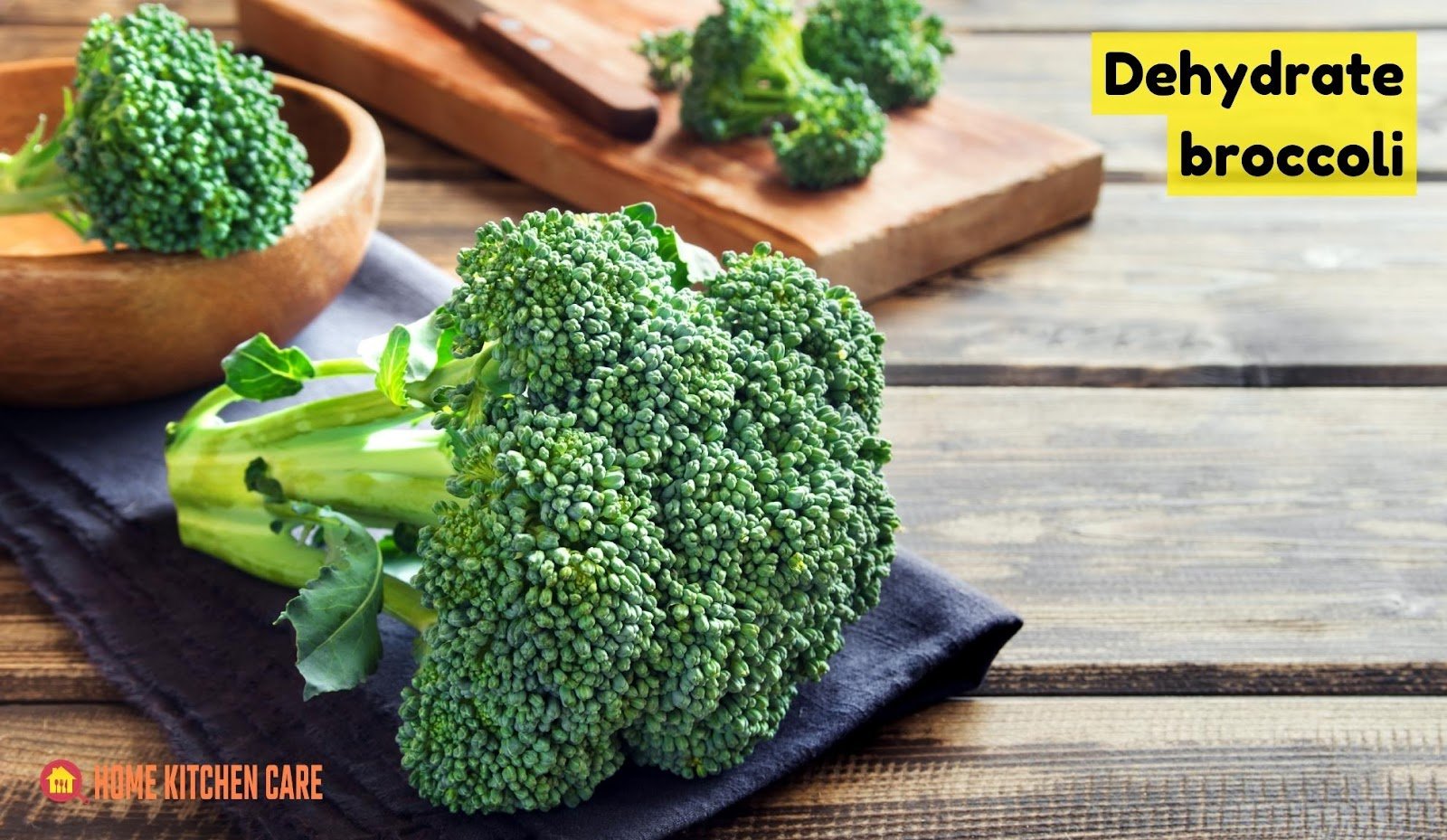Physical Address
304 North Cardinal St.
Dorchester Center, MA 02124
Physical Address
304 North Cardinal St.
Dorchester Center, MA 02124

Dehydrate broccoli, the secret to preserving the vibrant goodness of this nutritious vegetable for year-round enjoyment. If you’re looking to savor the taste and benefits of broccoli beyond its season, you’ve come to the right place. In this guide, we’ll unravel the art of dehydrating broccoli, taking you on a journey to discover the simplicity and versatility of this preservation method.
Get ready to embark on a flavorful adventure as we share tips, techniques, and creative ways to make the most of dehydrated broccoli. From crispy snacks to mouthwatering recipe enhancements, dehydrated broccoli is about to become your new culinary companion. So, let’s dive in and unlock the world of dehydrating broccoli together!
Main Summary: Steps to Dehydrate Broccoli
Wash and chop the broccoli into small pieces, then blanch briefly. Arrange on a dehydrator tray and dry at 125°F for 8-10 hours until crisp. Store in an airtight container for a nutrient-rich and delicious snack or addition to soups and stews. Enjoy the convenience dehydrated broccoli!

Dehydrating broccoli offers a wide range of benefits, making it an excellent method for preserving this nutritious vegetable. Let’s explore the various advantages in detail:
To ensure successful dehydration and optimal results when preserving broccoli, consider the following helpful tips:
Cut the broccoli florets into uniform sizes to ensure even drying. This allows for consistent dehydration and prevents some pieces from becoming over-dried while others may retain moisture.
Arrange the broccoli pieces in a single layer on the dehydrator trays to allow proper air circulation. Avoid overcrowding the trays, as it can lead to uneven drying and potentially extend the dehydration time.
Blanching the broccoli before dehydration helps preserve its vibrant green color. The brief boiling and subsequent ice bath shock the enzymes responsible for color deterioration, resulting in visually appealing dehydrated broccoli.
Before placing the broccoli in the dehydrator, gently pat the blanched florets dry using a clean kitchen towel or paper towels. Removing excess moisture helps speed up the dehydration process and ensures more efficient drying.
For added flavor, consider marinating the blanched broccoli florets briefly in a mixture of olive oil, herbs, or spices before dehydration. This can infuse the broccoli with complementary flavors, enhancing its taste when rehydrated and used in recipes.
During the dehydration process, periodically check the progress of the broccoli. Rotate the trays to ensure even drying and consistent results. Some dehydrators may have hot spots, so rotating the trays helps mitigate any variations in drying time.
To determine if the broccoli is adequately dehydrated, remove a piece and allow it to cool completely. It should be dry to the touch and have a brittle texture, indicating the absence of moisture. If the broccoli feels soft or pliable, return it to the dehydrator for additional drying time.
Consider adding a small desiccant packet or an oxygen absorber to the storage containers of dehydrated broccoli. These moisture-absorbing agents help minimize the risk of moisture reabsorption, keeping the broccoli crisp and extending its shelf life.
If you plan to rehydrate the dehydrated broccoli before use, soak the pieces in water or broth for approximately 15-30 minutes. This allows the broccoli to absorb the liquid and regain its original texture, making it ready for use in various recipes.
When storing dehydrated broccoli, label the containers with the date of dehydration. This helps you keep track of the freshness and ensures you use the oldest batch first. Proper labeling prevents potential wastage and ensures you enjoy the dehydrated broccoli at its best quality.
Dehydrating broccoli requires attention to detail and proper techniques to achieve the best results. Avoiding certain pitfalls can ensure the quality and flavor of your dehydrated broccoli. Here are some key things to avoid during the dehydration process:
While thorough dehydration is important, over-drying broccoli can lead to a loss of flavor, texture, and nutritional value. Monitor the drying process closely and remove the broccoli from the dehydrator once it is adequately dried but not overly crisp or brittle.
Inadequate blanching can result in enzymes not being fully inactivated, leading to color loss and diminished quality during dehydration. Be sure to follow the blanching instructions carefully to properly prepare the broccoli before drying.
Improperly arranging broccoli on the dehydrator trays can obstruct airflow and hinder the drying process. Avoid overcrowding or layering the trays, as this can result in uneven drying and increase the risk of spoilage. Ensure that the broccoli pieces are spread out in a single layer to allow proper air circulation.
Proper storage conditions are crucial for maintaining the quality and shelf life of dehydrated broccoli. Avoid storing it in areas exposed to light, moisture, or heat, as these factors can degrade the dried broccoli. Instead, store it in airtight containers in a cool, dark place to preserve its crispness and nutritional value.
Mixing different vegetables with significantly different drying times or moisture content can result in uneven dehydration and inconsistent texture. To maintain the quality of the dehydrated broccoli, it is best to dehydrate it separately from other vegetables.
Failing to check for dryness, brittleness, and moisture content can lead to inadequate dehydration or potential spoilage. Regularly monitor the drying process and conduct quality checks by removing a few pieces of cooled broccoli and ensuring they are adequately dehydrated before storing the rest.
For effective organization and tracking, it is important to label the containers of dehydrated broccoli with the date of dehydration. This allows you to use the oldest batch first and prevents potential wastage. Properly labeling and dating the containers help ensure you enjoy the dehydrated broccoli at its best quality.
Maintain a clean and hygienic workspace throughout the dehydration process. Thoroughly wash all equipment, utensils, and trays before use. Proper hygiene reduces the risk of contamination and helps ensure the safety and quality of the dehydrated broccoli.
Starting with fresh, high-quality broccoli is essential for achieving optimal results. Avoid using broccoli with signs of wilting, discoloration, or decay, as it can negatively affect the final product. Choose vibrant green broccoli heads that are firm and in prime condition.
Before dehydrating large quantities of broccoli, consider your available storage space. Dehydrated vegetables take up less space than fresh produce, but it is important to ensure you have adequate room to store the dehydrated broccoli properly without overcrowding.

Grind dehydrated broccoli into a fine powder using a blender or food processor. This vegetable powder can be used as a nutritious seasoning or flavor enhancer in soups, sauces, salad dressings, or even sprinkled over roasted vegetables.
Combine dehydrated broccoli with other dehydrated vegetables, nuts, and seeds to create a flavorful and nutritious snack mix. Add some spices or herbs for extra seasoning, and you’ll have a satisfying and portable snack for on-the-go or leisurely munching.
Crush or crumble dehydrated broccoli into small pieces and use it as a crunchy topping for salads. The concentrated flavor and texture of the dehydrated broccoli add a delightful twist to your greens, enhancing both taste and visual appeal.
Rehydrate dehydrated broccoli along with other dehydrated vegetables like carrots, bell peppers, and mushrooms. Use the rehydrated vegetable medley in stir-fries, omelets, or as a flavorful side dish.
Add dehydrated broccoli to homemade vegetable broth or stock to infuse it with a rich, broccoli flavor. Simmer the broth with the dehydrated broccoli for a delightful and nutritious base for soups, stews, and risottos.
Toss rehydrated dehydrated broccoli into pasta salads or grain bowls to add vibrant color, texture, and nutrition. The rehydrated broccoli complements the other ingredients, providing a burst of flavor and a healthy dose of vitamins.
Slice dehydrated broccoli into thin strips and bake them in the oven at a low temperature until crispy. These homemade vegetable chips make a nutritious alternative to store-bought potato chips and offer a satisfying crunch with a hint of broccoli flavor.
Add ground dehydrated broccoli to bread dough, muffin batter, or savory pastry fillings for a nutritious twist. The subtle flavor of the broccoli adds depth and complexity to your baked goods, making them even more enticing.
Mix powdered dehydrated broccoli with salt, garlic powder, and other desired herbs and spices to create a unique and flavorful seasoning salt. Use it to season roasted vegetables, grilled meats, or sprinkle over popcorn for a tasty snack.
In conclusion, dehydrating broccoli offers numerous benefits, including extended shelf life, preservation of nutrients, convenience, and versatility in culinary applications. However, it is important to avoid common mistakes such as over-drying, underblanching, poor air circulation, inadequate storage, mixing different vegetables, skipping quality checks, neglecting hygiene, using low-quality broccoli, and not considering storage space.
By following proper techniques and taking these precautions, you can successfully dehydrate broccoli, ensuring optimal flavor, texture, and nutritional value. Enjoy the convenience and creativity that dehydrated broccoli brings to your meals and snacks while savoring its vibrant taste and health benefits.
To dehydrate broccoli, start by selecting fresh broccoli heads without any signs of wilting or discoloration. Rinse the broccoli under cold water and cut it into bite-sized florets. Blanch the florets in boiling water for a few minutes, then transfer them to an ice bath to cool.
Pat dry the blanched florets and arrange them in a single layer on dehydrator trays. Set the dehydrator to a temperature between 125°F (52°C) and 135°F (57°C) and let the broccoli dry for 6 to 8 hours, or until crisp and brittle.
The best method for dehydrating broccoli is to blanch the florets briefly to retain their color and nutrients, then use a dehydrator to remove the moisture. This method ensures even drying and preserves the quality of the broccoli. While alternative methods like oven-drying or air-drying can be used, a dehydrator provides more consistent results and efficient dehydration.
Set your dehydrator to a temperature between 125°F (52°C) and 135°F (57°C) for drying broccoli. This temperature range ensures that the broccoli dehydrates properly while retaining its nutritional content and color. Adjusting the temperature within this range can help you achieve the desired level of crispness and dryness.
The time required to dehydrate broccoli can vary depending on factors such as the size of the florets, the humidity levels in your environment, and the efficiency of your dehydrator. On average, it takes about 6 to 8 hours to dehydrate broccoli fully. However, it’s important to monitor the broccoli regularly during the process and adjust the drying time as needed to achieve the desired level of dryness.
Yes, it is recommended to blanch broccoli before dehydrating. Blanching involves briefly boiling the broccoli florets, followed by an ice bath to cool them down quickly. Blanching helps preserve the color, flavor, and nutritional value of the broccoli by inactivating enzymes that can cause deterioration during the drying process. It also helps maintain the vibrant green color of the dehydrated broccoli.
Yes, you can dehydrate broccoli without a dehydrator using alternative methods such as air-drying or oven-drying. For air-drying, you can hang the broccoli florets in a well-ventilated area with good air circulation until they become dry and brittle.
For oven-drying, spread the blanched and dried broccoli florets on a baking sheet and set your oven to its lowest temperature. Leave the oven door slightly ajar to allow moisture to escape and dehydrate the broccoli until it becomes crisp.
To store dehydrated broccoli, ensure it is completely cool and free from any moisture before packaging. Place the dried broccoli in airtight containers such as glass jars, zip-lock bags, or vacuum-sealed bags. Store the containers in a cool, dry, and dark place, away from direct sunlight and humidity. Properly stored, dehydrated broccoli can last up to one year without significant loss in quality.
Dehydrating broccoli offers several benefits. It extends the shelf life of broccoli, allowing you to enjoy it beyond its season. Dehydrated broccoli retains its nutritional value, providing a source of vitamins, minerals, and antioxidants.
It is lightweight and portable, making it a convenient snack or ingredient for camping, hiking, or travel. Dehydrated broccoli is versatile and can be rehydrated for use in various recipes, such as soups, stews, stir-fries, and salads.
Yes, you can rehydrate dehydrated broccoli. To rehydrate, simply soak the dried broccoli in water or broth for about 15-30 minutes until it becomes plump and tender. The rehydrated broccoli can be used in recipes that call for fresh or steamed broccoli, providing a convenient option when fresh broccoli is not available. Keep in mind that rehydration may slightly alter the texture of the broccoli, but it will regain its flavor and nutritional value.
Dehydrated broccoli can be used in various recipes to add flavor and nutritional value. You can rehydrate it and use it as you would fresh or steamed broccoli in soups, stews, casseroles, pasta dishes, stir-fries, and salads.
Dehydrated broccoli can also be ground into a powder and used as a seasoning or added to homemade vegetable broth for a rich flavor base. Get creative and experiment with incorporating dehydrated broccoli into your favorite recipes for an added nutritional boost.